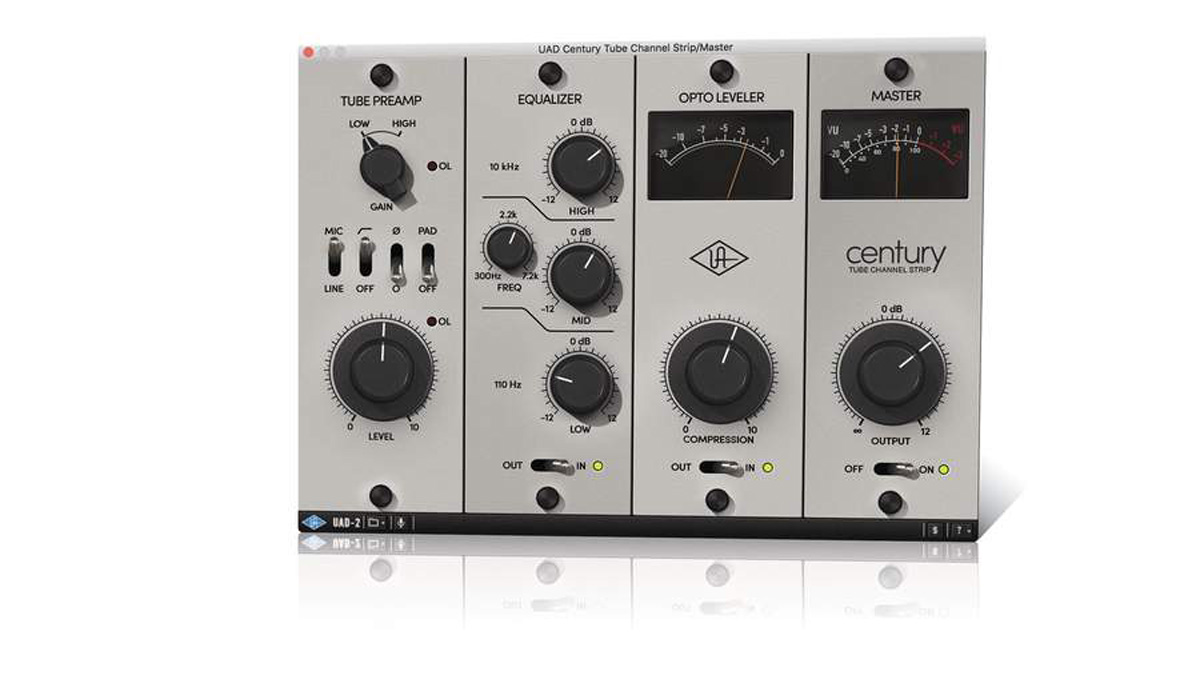MusicRadar Verdict
CTCS turns your UA audio interface into a responsive and fabulous-sounding analogue recording channel strip.
Pros
- +
Simple but comprehensive recording chain.
- +
Authentic tube sound.
- +
Smooth opto compression.
- +
Unison makes it feel real.
Cons
- -
A few more shelving EQ frequency options wouldn’t hurt.
MusicRadar's got your back
Chaining a virtual tube preamp, a three-band ‘sweetening’ EQ and a one-knob optical compressor in a single plugin, UA’s Century Tube Channel Strip for Apollo/Arrow/UAD-2 is an intuitive and immediate recording channel built to get vocals and instruments of all kinds sounding smooth and warm on the way into your DAW.
Of course, it’s also viable for mixing, but as the minimalism and simplicity of the thing imply, this is primarily a tracking strip: set it up on an input channel (guitar, bass, vocal, etc), hit record and commit. Old school.
Catch the tube
First in the chain is the Tube Preamp, which offers Low and High Gain settings for matching to condenser or dynamic microphones; an optional 18dB/octave high-pass filter at 80Hz for getting rid of unwanted low-frequency intrusions; a 20dB Pad function; and a polarity invert switch. The input Level knob piles on more and more valve saturation as it’s raised, from clean through warm, to full-on distorted. Overload indicators show clipping at both the input and output of the preamp.
Next comes the three-band EQ. The most complicated - for want of a better word - of the modules, this one’s covered in Easy EQ below. The Opto Leveler is an LA-2A-style optical limiter emulation comprising a single knob for dialling in the amount of compression applied.
In typical opto fashion, it delivers smooth and transparent peak reduction at low Compression levels, and more characterful dynamics shaping beyond that. At the end of the chain, the Master module is a simple output level control for re-levelling the processed signal.
While at no point does Century Tube Channel Strip get even vaguely overwhelming in either its concept or controls, obviously the EQ can’t possibly consist of just a more/less knob like the preamp and compressor. Nonetheless, it does still make two of the key decisions for you, with preset high-and low-shelving bands fixed at a generally useful 110Hz and 10kHz respectively, each with up to 12dB of cut or boost, for effortless broad-strokes control of the highs and lows.
It’s with the sweepable semi-parametric +/-12dB mid band that the user does have to get their hands mildly dirty, though. This is an adaptive Q design (ie, the peak filter resonance gets narrower as the gain increases), and with the centre frequency ranging from 300Hz to 7.2kHz, it’s useful for everything from upping the body of an electric bass to bringing out the best in a vocal, reducing acoustic guitar ‘squeak’ or balancing the snare within a mixed drum kit.
Century Tube is also Unison-compatible, adjusting the actual impedance of your Apollo or Arrow interface’s hardware preamps when loaded into their Unison insert points, and enabling hands-on rotary control of the Tube Preamp Low/High switch, and input Level and Output knobs in Gain Stage mode.
Scoring a century
With its stripped-back control set, Century Tube Channel Strip isn’t the most flexible of plugins - but that’s entirely by design. Its foolproof workflow will particularly endear it to musicians (as opposed to producers/engineers) looking to make their own quality recordings without having to learn the engineering ropes; and as long as you pay attention and keep your ears open, it really does make it difficult to go wrong when it comes to setting compression and EQ for vocals, guitars, basses, keys, and even the drums bus.
Indeed, UA describe Century Tube as a “do no harm” channel strip, and while that’s patently only accurate to a point, their summary certainly rings true within the bounds of conventional usage - rarely has finding the sweet spot for corrective EQ and compression been so quick and straightforward.
It’s such a great tool for the recording novice, in fact, that we reckon UA should make it part of their Apollo and Arrow bundles. It could seriously boost the (already considerable) appeal of those interfaces to the singer-songwriters that make up a fair proportion of their target market. Wishful thinking aside, though, this is a fast, focused plugin with a convincingly analogue sound that utterly flattens the channel strip learning curve. What’s not to like?
Computer Music magazine is the world’s best selling publication dedicated solely to making great music with your Mac or PC computer. Each issue it brings its lucky readers the best in cutting-edge tutorials, need-to-know, expert software reviews and even all the tools you actually need to make great music today, courtesy of our legendary CM Plugin Suite.
“Built from the same sacred stash of NOS silicon transistors and germanium diodes, giving it the soul – and snarl – of the original”: An octave-fuzz cult classic returns as Jam Pedals resurrects the Octaurus
What’s the buzz? Meet Yellowjacket, Cherry Audio's recreation of EDP’s trend-setting Wasp from 1978
“A fabulous trip through all eight songs by 24 wonderful artists and remixers... way beyond anything I could have hoped for”: Robert Smith announces new Cure remix album











